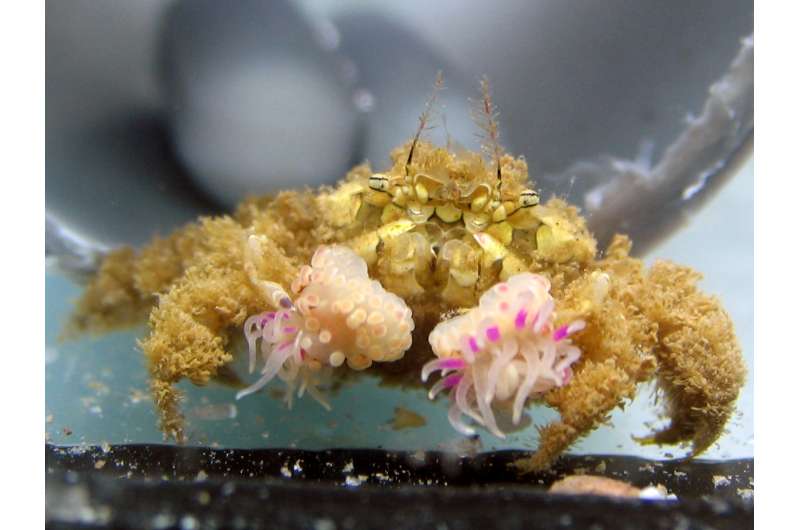Boxer crabs acquire anemones by stealing from each other, and splitting them into clones

Researchers have described a little known yet fascinating aspect of the behavior of Lybia crabs, a species which holds sea anemones in each of its claws (behavior which has earnt it the nickname 'boxer' or 'pom-pom' crab). In a series of experiments, they showed that when these crabs need an anemone, they will fight to steal one from another crab and then both crabs will split their anemone into two, creating identical clones.
Lybia crabs were first described in the 19th century, with only a handful of scientific publications since then, mostly dealing with morphology and occurrence, and less with their curious 'anemone wielding' behavior. Although quite common in the aquarium trade, the lack of attention given to them by the scientific community is presumably due to their small size and cryptic behavior.
In a new study, published today in the open access journal PeerJ, Yisrael Schnytzer and Yaniv Giman, both graduate students working under the supervision of professor Yair Achituv at Bar-Ilan University in Israel, and professor Ilan Karplus at the Volcani center, investigated various aspects of the crab-anemone association. Their study focused on trying to resolve a long-standing mystery—how the crabs acquire their sea anemones.
Over the course of several years more than 100 Lybia crabs were observed or collected from the shallow waters of the Red-Sea on the south shore of Israel in Eilat. These crabs are no more than a couple of centimeters across and have a similar color to the boulders under which they live—hence even finding them was a task in itself. Throughout the entire study, every single crab was found holding a pair of sea anemones which were identified as belonging to the genus Alicia, probably a newly recorded species.
Remarkably, despite extensive searching the team was unable to find any 'free living' Alicia. Thus, a series of laboratory experiments was employed, to gain an insight into how the crabs might come by their sea anemones in the wild.
A first experiment showed that when a sea anemone is taken from a crab, leaving it with just one, it will split the other into two fragments which then regenerate over the course of several days into two new clones. In the second part of the study a series of trials were conducted whereby a crab with sea anemones was placed in an aquarium together with one which had its anemones removed. The crabs would then proceed to wrestle—the crab without anemones would move to restrain one of the opponent's claws, and then remove part, or all, of a sea anemone. Most such encounters ended in a successful theft, and with no apparent damage incurred to either of the crabs. The crabs would then proceed to split their anemones, so that once again each held a pair!
Finally, the laboratory experiments were complemented with a molecular fingerprinting study of anemone pairs taken from wild caught crabs. Each crab was found to be holding identical clones, suggesting that the lab observed behaviors are presumably frequently used as a means to obtain their precious sea anemones in the wild.
The researchers report that this appears to be a unique example of one animal inducing the asexual reproduction of another, consequently also affecting its genetic diversity.
This study extends on a previous one investigating the costs and benefits of the association to each of the partner organisms, where it was shown that the crabs limit the anemones food intake and keep them at a small size ('Bonsai anemones'; J Exp Mar Biol Ecol 2013: 248-270).
More information: PeerJ, DOI: 10.7717/peerj.2954
Journal information: PeerJ
Provided by PeerJ




















